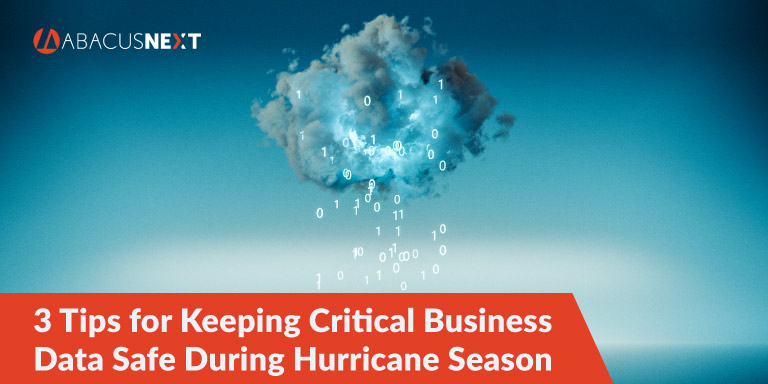3 Tips for Keeping Critical Business Data Safe During Hurricane Season


Meteorologists at Colorado State University recently released their initial forecast for the upcoming 2019 Atlantic hurricane season. From beachgoers to coastal property owners, people with plans or investments who may be impacted by a major storm have been anxiously awaiting these predictions, which are reputed to be among the nation’s most accurate.
Audiences were reassured to learn this season’s hurricanes are forecast to be no more severe or numerous than last year’s. The experts at Colorado State are calling for a total of 13 named storms (last year there were 15), with five of these storms becoming hurricanes and two becoming major hurricanes (Category 3 or stronger). This year’s outlook is for a season that’s only slightly above average.
Nonetheless, the risks these storms pose to your business are real. Hurricanes can strike anywhere along the U.S. coast and can have significant direct impacts as far as 100 miles inland. Flood-related damages caused by the torrential rains that accompany these storms can extend much further, even affecting properties that lie outside of high-risk flood zones.
According to The Federal Emergency Management Agency (FEMA), nearly four in 10 small businesses struck by a major natural disaster will close their doors permanently. Those with robust emergency preparedness and disaster recovery plans in place are far more likely to survive. A comprehensive plan will enable you to resume revenue-generating operations as quickly as possible, while also keeping your critical systems and valuable data safe. Here are three key tips to keep in mind as you plan for the upcoming hurricane season:
1. Outline and test a detailed, formal, written disaster recovery plan.
Full-scale disaster recovery planning encompasses more than just your technology assets. It also includes creating steps for your employees to take in case your offices are evacuated or damaged. How will you contact your team to ensure everyone’s safety? Could your business operate out of a temporary alternate location in the event of a disaster? Would your employees be able to maintain your operations by working from home or remotely until necessary repairs are made to your facilities?
It’s also essential to review your disaster recovery plan periodically with all employees. They should be adequately familiar with it to be able to take action in a time of crisis.
2. When it comes to data storage, think redundancy.
If your business-critical data is hosted at a single site, whether on-premises or in the cloud, you’re vulnerable. The cloud offers a perfect backup storage solution for many businesses, but the key is choosing a cloud service provider that offers geo-redundant data centers in multiple regions across the country. A hurricane can impact a large geographical area, so you’ll want your data to be replicated to a secondary region that’s hundreds of miles away from the primary data center.
If you’re already leveraging cloud-based services for key business applications, your employees can readily resume work from a remote location even if your offices are heavily damaged or without power for an extended period of time.
3. Pay attention to the physical security of your data center.
If you maintain an on-site data center, ensure that you’ve taken steps to secure the facility against possible wind and water damage. Hurricane shields should be installed on windows and doors, servers should be situated above the ground floor, and the building should be equipped with pumps.
Choose a cloud provider that will store your data in hurricane-rated structures located outside of flood zones with backup generators and redundant secondary backup power supplies available at all times.
Although this year’s hurricane season is forecasted to be less severe than last year’s, it only takes one severe storm to cripple your business. Make sure you have geo-redundant storage for your critical data assets, a robust disaster response plan, and backup solutions with no single point of failure. Then, you can rest easy knowing your business will be ready to face any storms that come your way.